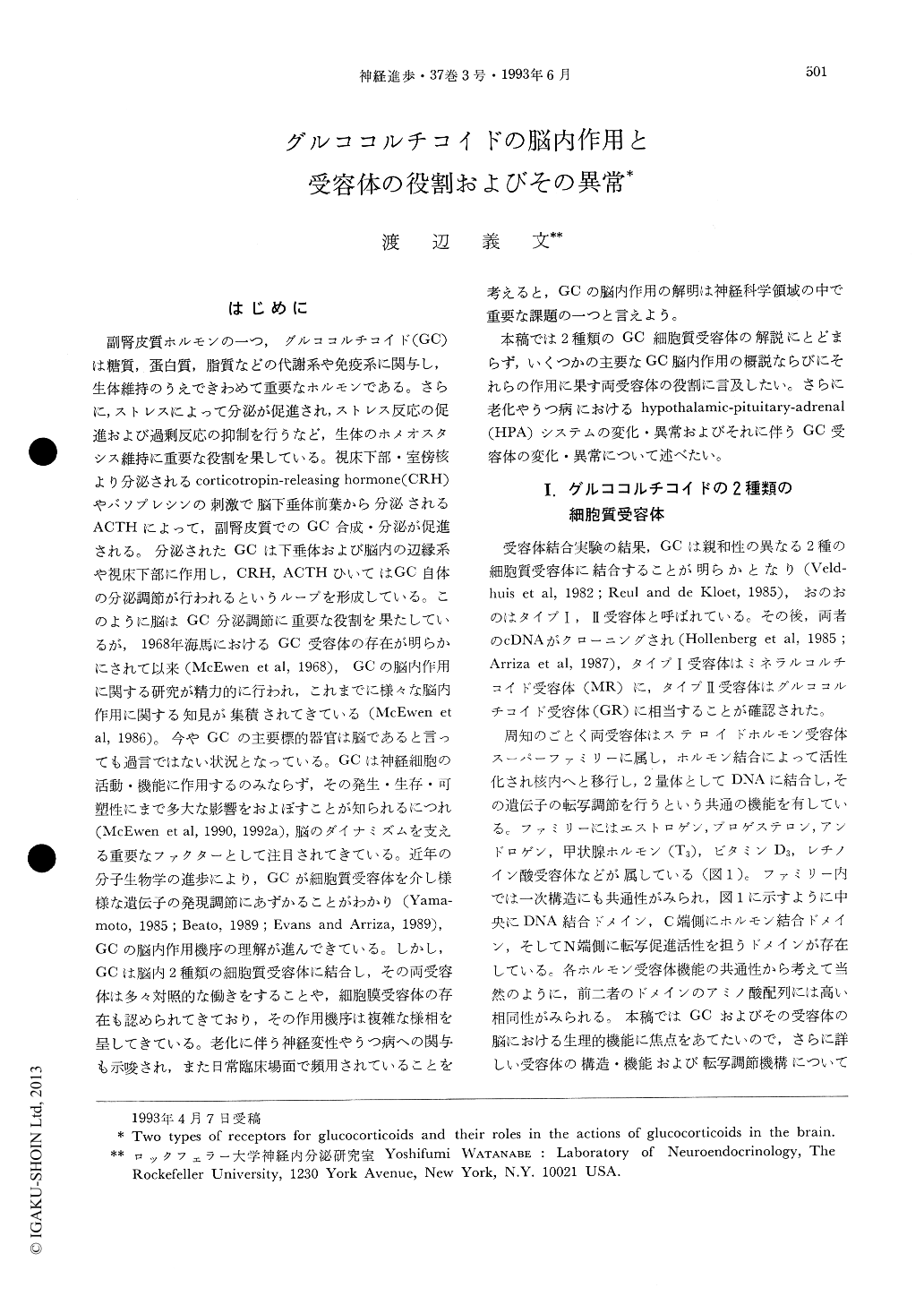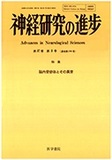Japanese
English
- 有料閲覧
- Abstract 文献概要
- 1ページ目 Look Inside
はじめに
副腎皮質ホルモンの一つ,グルココルチコイド(GC)は糖質,蛋白質,脂質などの代謝系や免疫系に関与し,生体維持のうえできわめて重要なホルモンである。さらに,ストレスによって分泌が促進され,ストレス反応の促進および過剰反応の抑制を行うなど,生体のホメオスタシス維持に重要な役割を果している。視床下部・室傍核より分泌されるcorticotropin-releasing hormone(CRH)やバソプレシンの刺激で脳下垂体前葉から分泌されるACTHによって,副腎皮質でのGC合成・分泌が促進される。分泌されたGCは下垂体および脳内の辺縁系や視床下部に作用し,CRH,ACTHひいてはGC自体の分泌調節が行われるというループを形成している。このように脳はGC分泌調節に重要な役割を果たしているが,1968年海馬におけるGC受容体の存在が明らかにされて以来(McEwen et al,1968),GCの脳内作用に関する研究が精力的に行われ,これまでに様々な脳内作用に関する知見が集積されてきている(McEwen et al,1986)。今やGCの主要標的器官は脳であると言っても過言ではない状況となっている。GCは神経細胞の活動・機能に作用するのみならず,その発生・生存・可塑性にまで多大な影響をおよぼすことが知られるにつれ(McEwen et al,1990,1992a),脳のダイナミズムを支える重要なファクターとして注目されてきている。近年の分子生物学の進歩により,GCが細胞質受容体を介し様様な遺伝子の発現調節にあずかることがわかり(Yamamoto,1985;Beato,1989;Evans and Arriza,1989),GCの脳内作用機序の理解が進んできている。しかし,GCは脳内2種類の細胞質受容体に結合し,その両受容体は多々対照的な働きをすることや,細胞膜受容体の存在も認められてきており,その作用機序は複雑な様相を呈してきている。老化に伴う神経変性やうつ病への関与も示唆され,また日常臨床場面で頻用されていることを考えると,GCの脳内作用の解明は神経科学領域の中で重要な課題の一つと言えよう。
本稿では2種類のGC細胞質受容体の解説にとどまらず,いくつかの主要なGC脳内作用の概説ならびにそれらの作用に果す両受容体の役割に言及したい。さらに老化やうつ病におけるhypothalamic-pituitary-adrenal(HPA)システムの変化・異常およびそれに伴うGC受容体の変化・異常について述べたい。
In the brain, glucocorticoids bind to two different cytosolic receptors, namely, the mineralocorticoid receptor (MR) and glucocorticoid receptor (GR), that are members of the steroid hormone receptor superfamily. Glucocorticoids produce various long-term effects on neuronal functions as well as neuronal structure via these receptors that regulate the expressoin of genes. Glucocorticoids also have rapid effects on cell membranes, so called non-genomic effects, and there is increasing evidences for membrane receptors for glucocorticoids. The two cytosolic receptors for glucocorticoids differ in their affinity for steroid hormones and their distribution in the brain. MR has a high affinity for both mineralocorticoid and glucocorticoids, and lower affinity for the synthetic glucocorticoid, dexamethasone (DEX), while GR has a high affinity for DEX and lower affinity for both mineralocorticoid and glucocorticoids. MR is highly concentrated in the hippocampal-septal system, while GR is fairly evenly distributed throughout the brain. Even during basal glucocorticoids secretion, MR is highly activated due to a high affinity for glucocorticoids, whereas GR is activated much less. The hippocampus is sensitive to circulaing levels of glucocorticoids and important in regulation of the diurnal rhythm of glucocorticoids. Glucocorticoids also regulate the two receptors differently. Only GR shows an up-regulation after adrenalectomy, while high-doses of glucocorticoids induce both MR and GR down-regulation. The hippocampus is the most sensitive brain region for these effects. Only very prolonged chronic stress however induces the down-regulation of MR or GR in normal conditions.

Copyright © 1993, Igaku-Shoin Ltd. All rights reserved.


